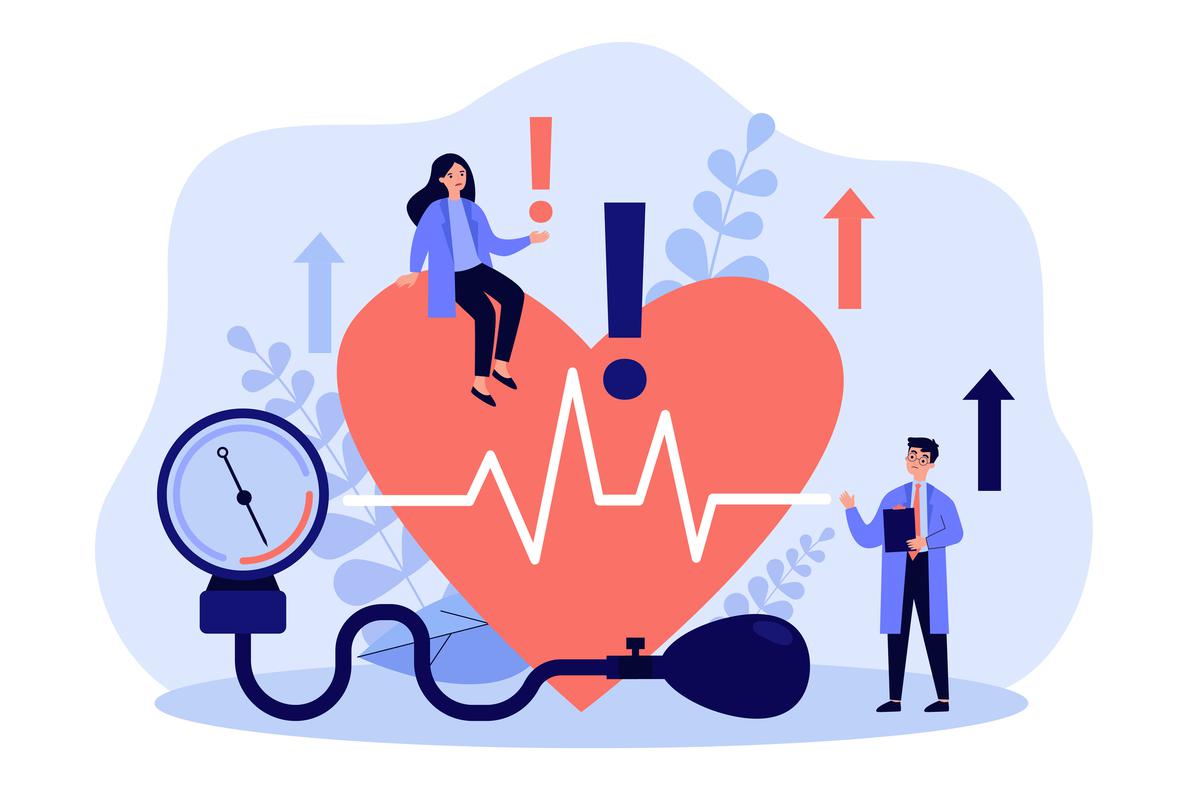Psychosomatic aspects of hypertension
High blood pressure or hypertension is a chronic medical condition in which the pressure in the arteries is elevated. Blood pressure is denoted by two numbers – the first number signifies our systolic (upper) pressure, while the second signifies diastolic (lower) pressure. Systolic refers to the pressure in the blood vessels that occurs during a heartbeat. Diastolic represents the pressure in the blood vessels when the heart rests between two beats.
What is hypertension?
The diagnosis of hypertension is established if, measured over two different days, systolic blood pressure is greater than or equal to 140 mmHg and / or if diastolic blood pressure is greater than or equal to 90 mmHg. Hypertension significantly increases the risk of developing heart, brain, kidney, and other diseases, and it is one of the leading causes of premature death worldwide. Today, it is estimated that about 1.28 billion adults between the ages of 38 and 79 suffer from hypertension. This makes up most of the population of low and middle socioeconomic status.
Types of Hypertension
There are two main types of hypertension: primary (essential) and secondary. Secondary hypertension refers to the type of hypertension in which we have a known cause, only 5-10% of cases fall into this type of hypertension. About 90-95% of all patients have primary or essential hypertension. Despite years of research into this type of hypertension, its exact cause remains unknown. Today, it is believed that the cause lies in a combination of genetic factors, diet, lifestyle, and age. Lifestyle changes can greatly contribute to lowering blood pressure, as well as reducing the risk of complications caused by hypertension.
The Psychosomatic Component
Essential hypertension is also thought to contain a psychosomatic component. But in order to talk about its presence, a necessary condition is that this psychosomatic component has been present long before the problems with blood pressure appeared. From a traditional medical point of view, the disease arises in such a way that some external force causes tissue damage and dysfunction. In the psychosomatic model, the disease develops differently – there’s a psychological factor, i.e., exposure to stress in various forms, which leads to dysfunction. If this lasts a long time, it brings about tissue damage. It is believed that there’s an emotional factor which plays a crucial role in the development of psychosomatic diseases.
The impact of emotional states
It’s important to note that, although it has been proven that emotional states can lead to a temporary increase in blood pressure, there is no evidence that this necessarily leads to a chronic state of high blood pressure. The causes of essential hypertension are multi-factorial (environmental, genetic influences, diet, activity level, etc.) and this must be considered when talking about psychosomatic aspects. The importance of the patient’s emotional state is clear in the assessment of hypertension treatment.
High Blood Pressure and Emotional Stress
Psychological factors may contribute to hypertension, along with other factors. There is a proven link between high blood pressure and acute emotional stress. Patients treated for arterial hypertension are predisposed to exhibit psychosomatic reactions when subjected to stressful conditions. High levels of stress can lead to a temporary increase in blood pressure. Stress-related habits – overeating, alcohol abuse, smoking, etc., can lead to further increases in blood pressure. Increased reactivity of the sympathetic nervous system can lead to increased heart rate, water, and salt retention in the body, and thus can contribute to a blood pressure rise. There are also some allegations that support the inhibited activity of the parasympathetic nervous system may be a contributing factor to hypertension.
What does hypertension look like?
When it comes to character traits, hypertensive patients show a mostly passive-dependent structure and an obsessive-compulsive structure. Also, more frequent internalized aggression, desire for self-control, high levels of situation-specific anxiety, frequent episodes of palpitations and tremors in were observed in patients with essential hypertension. Suppression of hostility tendencies is one of the important characteristics of patients living with hypertension.
In addition, there seems to be an internal conflict between passive and dependent aspirations on the one hand, and aggressive and competitive aspirations on the other. This leads to a conflict of anger and aggression with the need to suppress them for fear of rejection or loss of status. As in most psychosomatic patients, suppression of emotions or their non-expression leads to numerous physiological reactions. If someone consistently behaves in this way, it is considered that their behavior can lead to chronically high blood pressure, with all its clinical consequences.
Therapy work with hypertension
He will support the approach that is conducted in a “cordial and understanding” way. The difficulty of contact is increased by the therapist’s plan to work on their independence and increase their competitive capacity. Then they may feel vulnerable, intimidated, and may respond with maladaptive behavior. Therapeutic change can come through addressing perceived lack of support, encouraging the client to be more independent, and helping to understand the origins of their low self-esteem, as well as the root of a strong need for attention and support.
Considering the frequent personality traits and tendencies, I’d suggest trying two approaches: acceptance and commitment therapy, and gestalt therapy. Acceptance and commitment therapy is supportive enough to keep this client in the process but challenging enough to restore their responsibility and nurture independence and control over their own life.
Identifying Patterns
The emphasis here is on recognizing and accepting certain patterns and phenomena, in order for the client to learn to more easily endure the inevitable inconveniences that life brings, as well as to develop psychological flexibility. Gestalt therapy, with its acceptance of polarities and the theory of self, which implies that the self is formed on the border of contact and depends on the Other when we contact, could be a good way to reconcile the opposites within the person and to accept all those opposites can indeed coexist within one individual. These are only two of the many available and potentially useful approaches. And psychotherapy only tackles one risk factor, so it’s important to keep in mind other lifestyle changes that need to be introduced as well.
If you think that you can benefit from professional support on this issue you can reach out here.
Branka Mlinar is a psychologist and Gestalt therapist offering psychotherapy and counselling to adolescent and adult individuals. She’s mostly worked with problems of anxiety, interpersonal and relationship issues, procrastination, work-related stress, trauma, and grief.
References:
Ginger, S., Spargo, S., & Cojean, S. R. (2018). Gestalt therapy: the art of contact. Routledge.
Hayes, S. C., Strosahl, K. D., & Wilson, K. G. (2009). Acceptance and commitment therapy. Washington, DC: American Psychological Association.
Heine, B. (1971). Psychosomatic aspects of hypertension. Postgraduate Medical Journal, 47(550), 541.
Lazarević, M. Ž., & Jovović, S. M. (2017). Psihosomatske reakcije i hipertenzija u uslovima stresa. Opšta medicina, 23(1-2), 9-17.
Perini, C., Müller, F. B., Rauchfleisch, U., Battegay, R., Hobi, V., & Bühler, F. R. (1990). Psychosomatic factors in borderline hypertensive subjects and offspring of hypertensive parents. Hypertension, 16(6), 627-634. World Health Organization. (2013). A global brief on hypertension: silent killer, global public health crisis: World Health Day 2013 (No. WHO/DCO/WHD/2013.2). World Health Organization.







